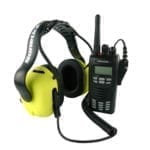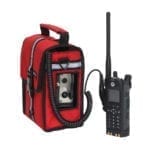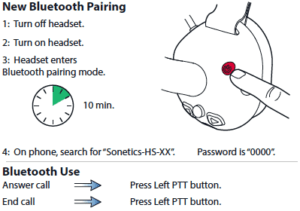Insight
Published and updated
How It Works: Connecting Two-Way Radios and Bluetooth Devices
Editor’s note: This article is part of our How it Works series. Other articles include: Full-Duplex Communication; Listen-Through Technology and Hearing Protection.
This is the age of mobility. With smartphones, laptops, email and Wi-Fi everywhere, it’s as easy to work remotely as it is to work in a remote location. Teams are global no matter where the jobsite, plant floor or work zone are located.
For team members in your immediate area (within 1,600 feet line of sight) Sonetics wireless headsets give you the ability to communicate hands-free with full-duplex clarity using the DECT7 standard. For team members who are miles away, you may want to connect a two-way radio. For communications outside two-way range, you may want to use your cell phone via the optional Bluetooth connection. Through your Sonetics wireless headset, you have a global reach.
How It Works: Two-Way Radio Connection

There are a couple of ways to connect a two-way radio so that it can be engaged with the push-to-talk (PTT) button on a Sonetics wireless headset. How your team needs to use the radio will help you decide which connection works best for you.
If a team member needs to have one-to-one conversations over the radio, then you can use a “direct-wire” setup. In this situation, you connect the radio directly to the headset with a Sonetics Portable Radio Adapter. Apex 3-Series wireless headsets are compatible with more than 400 two-way radio models.

If you want the whole team to be able to use the two-way radio, then your best option is to connect the two-way radio to the ComHub. This type of connection is also commonly used with vehicle-based radios. In this ComHub-connected setup, anyone on the team can engage the two-way radio and its remote user by pressing their headset’s PTT button.
One caveat and one cool feature…the caveat first: Because the two-way radio is only half-duplex, only one team member can engage the two-way radio at a time. The cool feature: If a team member moves beyond the range of the DECT7 connection, he or she can still engage the two-way radio in a direct-wire setup so long as they remain within the two-way’s operational range.
How It Works: Bluetooth® Connection

Smartphones continue to grow in popularity in work zones, especially as coverage has improved in recent years. Although cellular devices provide another means of communication, they can also present a few problems:
- When service is out, a smartphone becomes a brick as a communication tool, which is why DECT7 is so reliable for local team activities that tend to be more urgent and require real-time feedback and reactions.
- They require you to take your attention (and your hands) away from your primary task to answer, usually involving more steps than pressing PTT.
- If you’re wearing traditional hearing protection, you have to remove it to take a call.
You can overcome two of these problems (cellular service availability is beyond our control) with the Bluetooth® connectivity available in Sonetics APX379 wireless headset. The headset enters Bluetooth pairing mode for 10 minutes after it’s turned on. From there, it’s just like pairing your smartphone with your rig’s hands-free system or any other Bluetooth-connected device. To accept or end a call, simply press the menu (left PTT) button.
Because the Sonetics headset you’re wearing is also your hearing protection, you don’t have to remove anything or stop working to use the phone or its bevy of apps. You can also listen to music, your navigation system, use Skype or Facetime, and hear your device’s apps just as if you were in a quiet room talking with a group of people.
Use Case: Department of Transportation

Consider a Department of Transportation (DOT) road crew. Employees in the active work zone are DECT7-connected through their Sonetics wireless headsets. Flaggers, equipment operators, laborers, and a maintenance manager can all communicate hands-free without anyone’s transmission getting blocked or garbled by someone else hitting the PTT button at the wrong moment.
If you’re thinking that they’re isolating themselves by wearing a headset, think again. Worker can keep an ear on the traffic, and hear horns and warnings using the headsets’ Listen-Through technology.
This particular crew includes another flagger located a half-mile up the road and a pilot car driver, both of whom also wear Sonetics headsets. The driver communicates with DECT7 when she’s within range of the ComHub. After she’s out of range, she can still communicate with the team over the ComHub-connected two-way radio. The remote flagger doesn’t have access to DECT7 conversations, but he can still communicate with the entire team using his PTT to engage the ComHub-connected two-way.
There’s one more team member who needs to be included, or at least accessible: the supervisor located at the nearest DOT office 50 miles away. Both flaggers and the maintenance manager have Bluetooth-enabled headsets linked to their smartphones. They can communicate project updates, ask questions, report issues or allay concerns with another touch of their PTT button.
Communication Anywhere
In the age of mobility, there’s no excuse for poor communication. When you work in a job where productivity and safety are paramount, only the most advanced wireless communication system can be trusted. One that is designed for rugged performance in challenging work environments. One that plays well with other technologies to make sure you and your team never lose track of each other. Sonetics wireless headsets with two-way radio and Bluetooth integration give every team the greatest advantage over the day’s most difficult jobs.